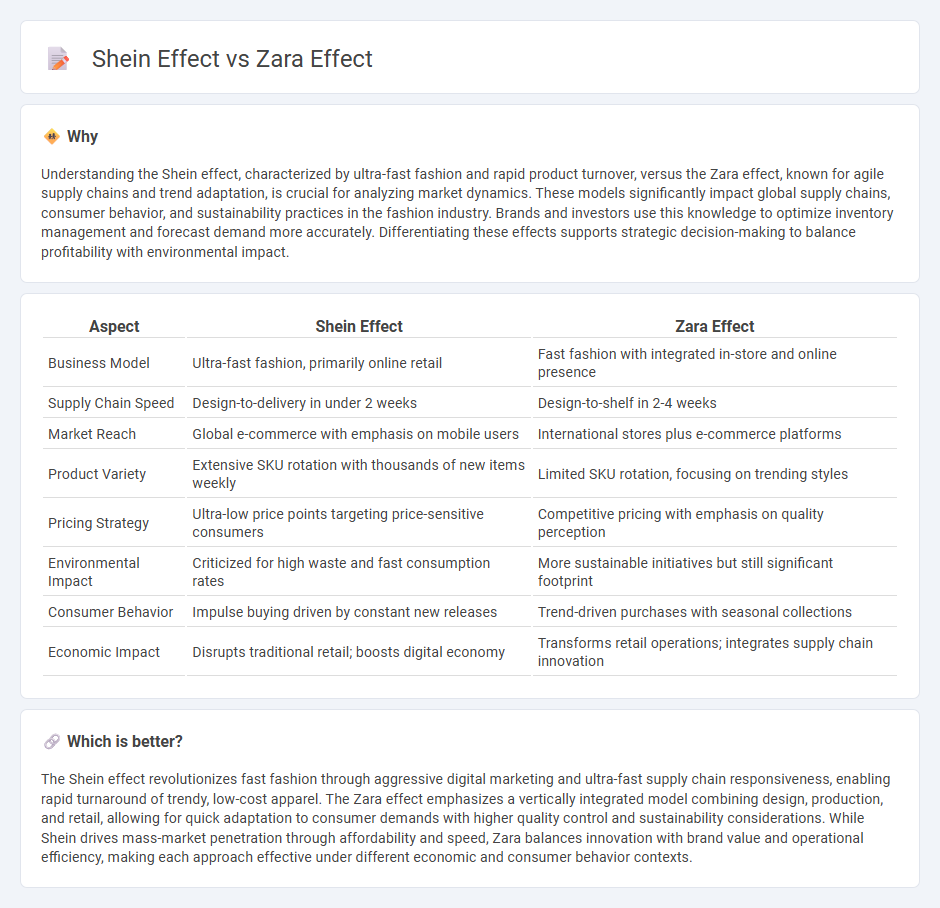
The Shein effect has revolutionized fast fashion by leveraging ultra-fast supply chains and data-driven inventory management, enabling the brand to rapidly respond to emerging trends at a fraction of traditional costs. In contrast, the Zara effect emphasizes efficient vertical integration and localized production to balance quality, speed, and sustainability within the competitive retail landscape. Explore the distinct economic impacts and business models shaping the future of global fashion markets.
Why it is important
Understanding the Shein effect, characterized by ultra-fast fashion and rapid product turnover, versus the Zara effect, known for agile supply chains and trend adaptation, is crucial for analyzing market dynamics. These models significantly impact global supply chains, consumer behavior, and sustainability practices in the fashion industry. Brands and investors use this knowledge to optimize inventory management and forecast demand more accurately. Differentiating these effects supports strategic decision-making to balance profitability with environmental impact.
Comparison Table
| Aspect | Shein Effect | Zara Effect |
|---|---|---|
| Business Model | Ultra-fast fashion, primarily online retail | Fast fashion with integrated in-store and online presence |
| Supply Chain Speed | Design-to-delivery in under 2 weeks | Design-to-shelf in 2-4 weeks |
| Market Reach | Global e-commerce with emphasis on mobile users | International stores plus e-commerce platforms |
| Product Variety | Extensive SKU rotation with thousands of new items weekly | Limited SKU rotation, focusing on trending styles |
| Pricing Strategy | Ultra-low price points targeting price-sensitive consumers | Competitive pricing with emphasis on quality perception |
| Environmental Impact | Criticized for high waste and fast consumption rates | More sustainable initiatives but still significant footprint |
| Consumer Behavior | Impulse buying driven by constant new releases | Trend-driven purchases with seasonal collections |
| Economic Impact | Disrupts traditional retail; boosts digital economy | Transforms retail operations; integrates supply chain innovation |
Which is better?
The Shein effect revolutionizes fast fashion through aggressive digital marketing and ultra-fast supply chain responsiveness, enabling rapid turnaround of trendy, low-cost apparel. The Zara effect emphasizes a vertically integrated model combining design, production, and retail, allowing for quick adaptation to consumer demands with higher quality control and sustainability considerations. While Shein drives mass-market penetration through affordability and speed, Zara balances innovation with brand value and operational efficiency, making each approach effective under different economic and consumer behavior contexts.
Connection
Shein and Zara significantly influence the fast fashion economy by driving rapid production cycles and consumer demand for affordable, trendy apparel. Their business models leverage data analytics and supply chain optimization to minimize lead times, boosting market responsiveness and revenue growth. This interconnected approach reshapes global fashion consumption patterns, emphasizing speed, cost-efficiency, and mass accessibility.
Key Terms
Fast Fashion
The Zara effect emphasizes rapid design-to-retail cycles by leveraging vertical integration and in-house production, enabling swift trend adaptation that reshapes fast fashion dynamics. The Shein effect, characterized by aggressive digital-first strategies and data-driven inventory management, accelerates global market penetration and ultra-fast consumer demand response. Explore detailed comparisons and implications to understand how these models redefine fast fashion's future.
Supply Chain Agility
Zara's supply chain agility leverages real-time data analytics and a vertically integrated model to achieve rapid design-to-retail cycles, often within two weeks. Shein relies on a flexible supplier network and AI-driven demand forecasting to quickly adapt to micro-trends, enabling ultra-fast production turnaround. Explore more about how these supply chain strategies redefine fashion retail efficiency and responsiveness.
Ultra-Fast Retail
The Zara effect revolutionized ultra-fast retail by streamlining the supply chain to deliver fashion trends from design to store shelves in weeks, setting a new industry benchmark. The Shein effect intensified this paradigm by leveraging digital platforms and data analytics to push turnaround times to days, fueling the rise of ultra-fast fashion that caters to hyper-specific consumer demands globally. Explore the evolving impact of these retail giants to understand the future of ultra-fast fashion dynamics.
Source and External Links
Zara Effect (Fast Fashion Strategy) - Adogy - The Zara Effect refers to a fast fashion business model where new clothing items are rapidly produced and distributed based on real-time consumer trends and data, enabling brands like Zara to quickly respond to changing customer demands.
Biography of Gregorio Zara, Inventor of the Videophone - ThoughtCo - The Zara Effect is a physical law discovered by Filipino scientist Gregorio Zara, describing electrical kinetic resistance that occurs when contacts are in motion during the passage of an electric current.
Gregorio Y. Zara - Wikipedia - The Zara Effect, named after Gregorio Zara, is the physical law of electrical kinetic resistance, one of several scientific contributions by this pioneering Filipino inventor and engineer.
 dowidth.com
dowidth.com